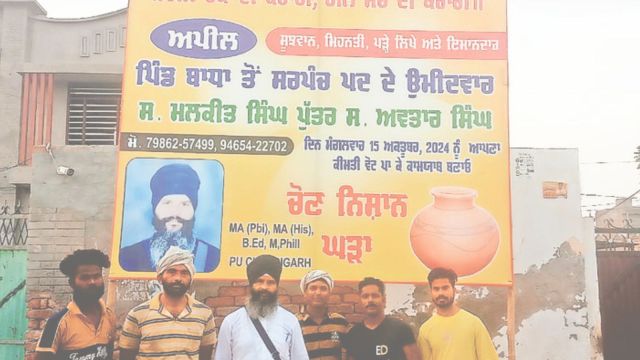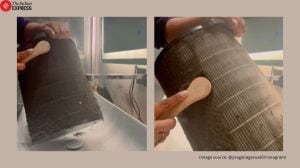This farmer in Punjab’s Fazilka is fighting with a message: ‘No to stubble burning’
On the four acres, Virk grows citrus fruit 'mitha' (Indian sweet lime) with natural quinine and provides immunity against dengue and malaria fevers.
 Malkeet Virk also has a YouTube channel 'Fazilka Farming' (Express photo)
Malkeet Virk also has a YouTube channel 'Fazilka Farming' (Express photo)Malkeet Singh Virk (38) of Badha village in Fazilka district says he is the only one in this village who has not burned fields since 2018 and, as a result, the soil fertility has improved and has been improving each year. Taking this message forward, Virk — a postgraduate in history and punjabi , a BEd and an MPhil — is in the fray for the post of a sarpanch. Badha village has 1,305 votes.
“I am the only farmer in this village who does not burn fields. I want to spread this message among farmers and want them to show my field for its fertility. If I win, I will take forward this message to the farmers and convince them not to burn stubble in their fields,” Virk, whose farm spreads over 20 acres, with paddy on 16 acres, said.
Virk has a YouTube channel ‘Fazilka Farming’ where he shares his experience about farming and the benefits of not burning fields.
“I have sown PR 126. I follow mulching after harvesting paddy using a combine harvester with the straw management system (SMS). With SMS, the leftover paddy straw in the field is minimal and then the mulcher mixes straws with the soil. A reversible plough is used in fields and a rotavator thereon is used to prepare fields for wheat sowing with the help of a happy seeder. It takes four to five days to prepare an acre, but it’s worth waiting,” Virk said.
“When I used to burn fields after harvesting, my cost on fertilisers and pesticides would be around Rs 7,000 per acre for the wheat crop, which has now reduced to around Rs 5,000 per acre. For paddy, it used to be around Rs 8000 per acre, which now is around Rs 5000 per acre. The costs of harvesting, ploughing, etc., are almost the same. However, it is a win-win situation as the yield of the wheat crop has increased from 20 quintals per acre to 26-28 quintals while the paddy yield has increased from 30 quintals an acre to 34-36 quintals,” he said.
On the four acres, Virk grows citrus fruit ‘mitha’ (Indian sweet lime) with natural quinine and provides immunity against dengue and malaria fevers. “I got first prize for my fruits at a Kisan Mela organised by PAU last month.
Virk got his qualification printed on his posters. He passed out from Panjab University, Chandigarh. “I wanted to get educated to enhance my knowledge, but I was always interested in farming. Farmers should educate themselves to improve farming techniques and thinking processes because farming techniques are very scientific. People often think only illiterate people do farming, but educated people must also do some farming.”
Talking about his decision to contest the panchayat polls, Virk said, “Sarpanch is the head of the gram panchayat, the first pillar of democracy. If well educated, a sarpanch can understand various government schemes for villages. I will work on harvesting rainwater if I win.”







